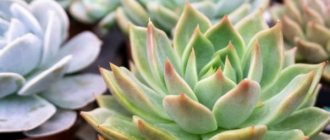Author: Elena N. https://floristics.info/ru/index.php?option=com_contact&view=contact&id=19 Category: Houseplants Published: February 02, 2019Last edits: January 11, 2021
- The myrtle has dried up
- Properties of myrtle
- Common myrtle (Myrtus communis)
plant (lat. Myrtus) belongs to the genus of evergreen woody plants of the Myrtaceae family, the flowers of which contain essential oil. The natural habitats of myrtle are the Mediterranean, the Azores and the north of the African continent. It is no coincidence that the name of the plant is consonant with the Greek word “myrrh”, which means “balm, liquid incense”, because it is as a cult attribute that myrtle essential oil has long been used in temples of various concessions. Legend says that Adam, expelled from Eden, brought the myrtle flower with him to Earth as a memory of the lost paradise. Many peoples have many myths, beliefs, traditions, rituals and signs associated with this plant. The myrtle tree has long been considered a symbol of glory, peace and hope. Our ancestors had myrtle flowers not only for cult purposes, but also for medical and cosmetic purposes, and some myrtle preparations are still popular today. But for plant lovers, a blooming and fragrant myrtle is an object of admiration and a source of aesthetic pleasure, especially since home myrtle is undemanding in care, and those who know how to care for myrtle can easily achieve the optimal shape for a plant that will decorate your home and help preserve To your health.
Planting and caring for myrtle
- Flowering: June-July.
- Lighting: bright sunlight until noon, then bright diffused light (southern, western and eastern windows).
- Temperature: in summer – normal for residential premises, in winter – 5-10 ˚C.
- Watering: in summer - frequent and plentiful; in cool seasons, watering is reduced.
- Humidity: high. Daily spraying of leaves is recommended, especially in hot weather.
- Feeding: from March to August once a week with complex mineral fertilizers.
- Dormant period: winter; in cool conditions - up to three months, in normal conditions - a month and a half.
- Replanting: young plants - annually, adults as needed.
- Pruning: after flowering or early spring.
- Reproduction: cuttings, less often seeds.
- Pests: scale insects, aphids, spider mites, whiteflies, mealybugs.
- Diseases: root rot.
Read more about growing myrtle below.
How to care?
Tangerine tree care at home: a generalized view
Caring for myrtle depends on the season. As already mentioned, he appreciates fresh air. In this regard, in the summer the crop can be moved to the balcony or even to the garden. If the plant is in a room, it is necessary to ventilate the room daily. In winter, you need to provide myrtle with soft light and moderate coolness. If the leaves begin to drop, it means the flower is hot. The situation is not critical; it is enough to change the location of the tree. As for the lush appearance, it will be restored in the spring.
Overwintering the plant at room temperature is acceptable. However, in this case, abundant soil moisture and frequent spraying are necessary. This will also be required in the summer. Myrtle loves high humidity, which is explained by its origin. It would be useful to use special devices that humidify the air.
Watering
During the warm period, the crop needs to be watered regularly, but in moderation. The signal for the procedure is the dryness of the top layer of soil. In winter, irrigation should be modest. The main thing is not to let the entire soil dry out. One watering per week is the optimal solution.
Drying out the soil leads to yellowing of the foliage and death of the plant. Therefore, if a forgetful gardener discovers such a problem, the lack of humidity is urgently compensated. At the same time, stagnation of water in the soil is also undesirable.
It is important to maintain the optimal volume of incoming moisture
Top dressing
To grow a healthy and beautiful plant, you need to remember about feeding. During the active period, myrtle needs to be fertilized every week. In winter, fertilizing is carried out once every 4 weeks.
In winter time
In winter, you need to reduce the amount of fertilizing and watering. In addition, it is advisable to maintain a temperature regime suitable for the plant. Otherwise, care remains the same, nothing special needs to be done.
Botanical description
Myrtle, which according to various sources has from forty to one hundred species, in its natural habitat can grow up to three meters in height, and indoor myrtle, under the most favorable conditions, reaches only a meter. Usually myrtle at home is a tree with a round crown 30-60 cm tall. Small leathery, as if polished, leaves of myrtle are located on the shoots sparsely and oppositely on short petioles, they have an elongated shape, the tops of the leaves are pointed. Flowers, simple or double, are either single or collected in a raceme. The fruit is a nut or drupe berry.
An interesting fact is that myrtaceae include such valuable plants for humanity as tea tree, eucalyptus, and clove tree.
Choosing a location and lighting
In winter and summer, myrtle can be found in different places. The plant is very light-loving, but scorching midday sun rays can burn the foliage. Insufficient lighting can cause a lack of flowering.
Growing a myrtle houseplant outdoors in the summer is the most favorable place. A balcony or veranda will do here. You can even plant a tree in your garden plot along with a pot.
In indoor conditions, western or eastern windows are well suited. When placed near a south window, it is recommended to shade it to prevent burns. In the northern one, it may result in poor flowering due to insufficient light.
Dry air from a battery in winter can lead to adverse consequences when placed on a windowsill. During this period, the kitchen may be an alternative option: there the temperature is higher and the air humidity is higher.
It is advisable to gradually change the summer and winter lighting conditions, gradually moving the flowerpot closer or further from the window.
Growing myrtle from seeds
How to propagate myrtle by seeds at home? At the beginning of spring, myrtle seeds are sown on the surface of a substrate consisting of equal parts of sand and peat, in a container 7-10 cm deep, sprinkled on top with a layer of the same substrate 3-5 mm thick and, covered with glass, kept at a temperature of about 20 ºC, ventilating and moistening the crops, as well as removing condensation from the glass.
- Photos of coloria species with names
Shoots appear in a week or two, and when the seedlings grow 2-3 true leaves, they are planted in the same substrate in individual pots so that the root collar remains above the soil surface. A month after picking, the seedlings are fed with nitrogen fertilizer of weak consistency.
However, amateur breeders should know that myrtle grown from seeds:
- will bloom no earlier than in 4-5 years;
- is unlikely to retain varietal characteristics.
In addition, the germination of myrtle seeds sharply decreases after just a year of storage, and obtaining them is problematic, since this will require artificial pollination of the plant.
How to replant myrtle after purchase
A mandatory step after purchasing myrtle is to transplant it into a new container. For planting, it is recommended to use a soil mixture, which must include equal parts of turf soil, peat, humus and fine river sand. Replanting the crop is carried out using the classical method, with a complete replacement of the earthen clod.
Replanting activities are carried out according to the following scheme:
- line the bottom of the new container, which should be 2–3 cm in diameter larger than the previous one, with a drainage layer using expanded clay or pebbles;
- cover the drainage layer with a small layer of prepared substrate;
- Carefully, holding the lower part of the trunk, pull the plant out and inspect the root shoots. If there are dry, damaged, rotten roots, remove them with a sharp knife. Sprinkle the cut areas with crushed activated charcoal or charcoal. Completely rid the root system of old soil;
- place the myrtle in the pot, carefully leveling the root shoots;
- sprinkle the crop with the remaining soil, leaving the root collar above the soil level;
- Water the planted plant, and be sure to drain the remaining moisture in the tray.
The planted flower is placed in a well-lit place, providing it with peace for 7-10 days so that it can quickly get used to new conditions.
Video: Transplanting myrtle
Caring for myrtle at home
Growing conditions
Caring for myrtle at home includes watering, pruning and feeding the plant, as well as creating optimal or at least necessary conditions for it. The myrtle houseplant prefers southern, western and eastern window sills and is tolerant of drafts, temperature changes and direct sunlight. Moreover, if there is no sun, the myrtle will not bloom. In summer, myrtle prefers life in the fresh air; in winter, the plant needs coolness - 5-10 degrees Celsius, and the best place for it would be a glazed, unheated balcony.
In the warm season, myrtle should be watered Insufficient or infrequent watering can cause the plant to drop its leaves. With the onset of cold weather, watering is reduced, but if the plant spends the winter indoors with heating devices running, it will have to be watered just as abundantly as in the summer.
In addition, there will be a need to spray the leaves of the plant with water at least once a day, since myrtle needs high air humidity, and you need to remember this in winter, if the temperature in the room with myrtle is above 15 ºC, and in summer. Water for water procedures and irrigation must be settled or passed through a filter.
Once every week or two from March to August, myrtle needs fertilizing. If you are growing a bonsai from myrtle or you are not interested in its flowering, then feed the plant with a complex fertilizer for ornamental foliage plants, but if you want to see myrtle bloom, then apply fertilizer for flowering plants.
- Dieffenbachia - care, photos, types
Myrtle has a pronounced dormant period, the duration of which determines the location of the plant: if myrtle overwinters in a cool place or on a northern windowsill, then it can rest for up to three months, and if it is warm and in bright light, then only for one and a half months.
Trimming
Caring for myrtle also involves giving its crown the desired shape. The formation of myrtle depends on what you are growing it for. Many people like myrtle in the form of a standard tree with a neat compact crown, but there are people who do not care what the plant looks like, as long as it “blooms and smells.” In any case, do not get too carried away with pruning the side shoots of young plants or pinching them excessively.
On the other hand, myrtle grows quickly, is easy to regenerate, and you always have the opportunity to change your plans for its appearance. The main thing is that the formation of the crown should be done in early spring or after flowering.
Transfer
Young plants are replanted annually, adult myrtles - as needed, which is determined in this way: if the freshly watered soil dries out within 24 hours, then it is time to increase the amount of substrate, and, therefore, a larger pot will be needed. Choose a pot that is only a couple of centimeters in diameter wider than the previous one. It is better to replant in the spring, using the method of transferring the plant from an old container to a new one, since it does not injure the root system.
Purchase and adaptation
The key to beautiful, lush flowering and long life of myrtle is a healthy and strong plant. Therefore, when choosing a crop in a flower shop, it is recommended to pay attention to:
- leaves - they should have a shiny surface, elastic, durable structure, and have a rich dark green color;
- branches - must be strong, flexible, without yellowness and dryness;
- soil - should have a slightly moist structure.
The presence of dry, yellowed leaves, too dry and stagnant soil indicates that the basic rules for growing a flower have been violated, in particular, non-compliance with the watering and fertilizing regime, lack of lighting, etc.
Immediately after purchase, the flower needs to be replanted with a complete replacement of the earthen coma. New soil enriched with valuable components will allow the plant to quickly adapt to new conditions and sprout.
Myrtle propagation
If you want to propagate myrtle, then the best way to do this is cuttings, because it allows you to preserve the species and varietal characteristics of the plant. In addition, this is a much more reliable method of propagation than seed, and plants from cuttings bloom faster than those from seeds - in three years. Therefore, if you want to grow a myrtle tree at home, you don’t need to buy seeds that quickly lose their ability to germinate, just don’t be shy to ask your friends for a cutting after formative pruning. The best results are obtained from semi-lignified cuttings of the current year.
You can take cuttings from January to February, or in July, and it is better if they are from the lower or middle part of the crown. Remove the lower leaves from a piece of shoot 8-10 cm long, shorten the upper ones by a third, and the largest ones by half. Treat the lower cut with root or heteroauxin and plant for rooting in a mixture of leaf soil (one part) and coarse sand (half part), or sphagnum and sand in the same proportions. It is better to take a low and wide container for rooting, and it is advisable to cover the top of the cutting with a glass jar.
Rooting occurs at a temperature of 17-20 ºC in a shaded place. From time to time the jar is removed for ventilation and to prevent the soil from souring. Usually the roots grow within a month, and the rooted cuttings are transplanted into a pot with a diameter of 7 cm in the same soil mixture. After a year, transplant it into a container with a diameter of 9 cm in the soil for an adult myrtle and care for it as for an adult plant.
- Photo by Irezine Herbst
Transfer
Myrtle grows slowly and does not need frequent replanting. It is enough to do this every 3 years if he is an adult. For a young flower, the frequency is once every 12 months. It's better to do this in the spring. When replanting, the new pot should be slightly larger than the old one.
At its bottom, be sure to first lay drainage, and then the prepared substrate. Place the tree in a pot and cover the roots with soil. Level the soil and water the flower.
Tip : to make it easier to remove the plant from the pot when replanting, do not moisten the myrtle for several days beforehand. If the soil is dry, it will be much easier to get it out of the soil.
Pests and diseases
Myrtle is harmed by mealybugs, whiteflies, scale insects, aphids, thrips and spider mites, which appear as a result of chronic violation of the rules of plant maintenance. The first five pests are destroyed by treating myrtle with actara or actellik four times over the course of a month. It is advisable to wash off spider mites and thrips with a shower before treating with the same Actellik. But rather than poisoning myrtle with insecticides, it is better to prevent insect invasion by following very simple rules for caring for the plant.
The myrtle has dried up
A frequently asked question from our readers: “What to do if the myrtle has dried up?” should sound different: “What should I do to prevent myrtle from drying out?” And the answer to this question is very simple: strictly follow the rules for keeping myrtle. If the leaves of myrtle dry out, it means that you have not taken into account any of the recommendations of experts on caring for the plant. Insufficient air humidity has an adverse effect on the condition of the foliage, especially if in winter the myrtle is in a room with a temperature above 18 ºC, where heating devices operate, not only heating, but also drying out the air.
Myrtle also dries out if you forget to water it. Remember the rules for caring for a plant and follow them strictly, because it is much easier to prevent the death of a plant by taking preventive measures than to resuscitate it later. Water and spray the myrtle regularly with settled water, keep it on a tray with wet pebbles, but so that the bottom of the pot does not stand in water.
Watering and air humidity
Subtropics are the homeland of myrtle. Therefore, when choosing a watering regime, you must strive to create conditions native to the plant. In summer, you should water abundantly, but do not allow excessive overflow of the substrate.
The tree also likes daily spraying of foliage, and on the hottest days - several times a day. At the slightest drying out of the soil, the leaves of the tree may turn yellow. With a longer drought, they fall off, and then the death of the plant follows.
Caring for a myrtle houseplant requires high humidity. It can be increased if the flowerpot is placed on a tray with wet gravel or expanded clay, or by placing containers of water around the flowerpot.
In winter, the plant has a pronounced dormant period. Therefore, it requires a more moderate supply of moisture: you can water it 1-2 times a week, spray it 2-3 times. During this period, the frequency of watering and spraying depends on the temperature, air humidity and amount of light.
Only settled water is suitable for watering and spraying myrtle.
Properties of myrtle and signs
Properties of myrtle
The leaves, young shoots and fruits of myrtle contain essential oil and active substances that have a high antibacterial effect. Soviet scientists developed a medicinal drug - tincture of myrtle, which is prepared from the mature leaves of the plant. Both the experience of traditional medicine and modern scientific research confirm that the use of myrtle in the treatment of such serious diseases as diabetes, pneumonia and chronic bronchitis is highly effective.
Myrtle tincture successfully combats antibiotic-resistant strains of tuberculosis bacillus and staphylococcal infections, as well as purulent otitis media and severe smoker’s cough. In addition, the drug from myrtle leaves is a natural stimulator of important life processes that increase performance and endurance to stress; it has no side effects and is prescribed even to children from one year of age.
Doctors and botanists recommend keeping myrtle in bedrooms and children's rooms because it makes the air in them cleaner and healthier. One plant can purify the air of bacteria in a room of 20 square meters. meters.
Signs
Myrtle has long been considered a strong amulet. But the plant will fulfill this purpose only under two conditions:
- if it was planted by a woman - the mistress of the house;
- if the owners of the plant are proud of their myrtle.
Signs of European peoples say: if myrtle grows in a house, there will be peace and love in it, but if the plant dies and is thrown away, happiness will leave this house along with the dead plant. Myrtle is not suitable for offices - it needs a family hearth.
But Muslims do not keep myrtle in their homes, believing that it dooms young boys and girls living in the house to loneliness.
Landing
Planting myrtle
quite an easy procedure. It is best to use cuttings for this (a lot of troubles can arise with seeds).
The cutting will be able to take root very quickly if it is placed in a container of water. As soon as the first shoots begin to appear, you can start planting the flower.
If you pluck the branches in the middle or end of the spring season, you significantly increase the likelihood that after planting the plant, the myrtle will grow lush and healthy.
Typically, plant growth can last from 3 to 5 years.
Location and lighting
After the myrtle has been planted, you need to think about where to place it in the house. The most suitable option may be window sills, which will be located from the west or east. If this is not possible, and you have to place the flower on the south side, then it is necessary to protect the plant from direct rays of the sun. Otherwise, the myrtle will not bloom, and its leaves will quickly fade.
It is believed that myrtle tolerates natural light well. But still, you need to be careful. If exposed to the sun for a long time, the plant may get sick and die. It is for this reason that in the summer it is necessary to worry about a suitable location for the flower in the house.
Pot size
When carrying out the replanting procedure, you need to worry about a new pot for myrtle in advance. If the plant has reached its maximum size or is still growing, then it is best to purchase a pot that is 2-3 times larger than the original one. You need to pay attention to tall and wide plastic pots, because quite often the root system of a flower grows greatly and begins to extend beyond the edges of the pot. With the right choice of this accessory, such trouble should not happen.
A pot that is too large is also dangerous. In this case, all the liquid will flow to the bottom, and the root system will absorb it. With prolonged exposure to moisture, the process of rotting may begin. Therefore, it is very important to monitor how often the flower is watered.
The soil
If you plan to grow myrtle in the house, then it would be best to prepare the soil, which will consist of turf soil, ordinary sand and humus. Before planting, all components are mixed together in a 1:1:1 ratio.
When purchasing land from a flower shop, preference should be given to soil for palm trees.
Transfer
After the winter cold has passed, the plant must be replanted. Before this procedure, it is necessary to purchase a convenient and correct size pot and prepare the soil, which will promote the active growth of the Mediterranean plant. The soil can be purchased at a specialized store, or you can prepare the soil yourself. Here everyone has the right to decide for themselves.
First of all, drainage is laid out at the bottom of the pot. For this you can use ordinary pebbles or coarse sand. The drainage layer is standard and is at least 3 centimeters. After this, a little soil is poured into the pot and the plant itself is placed. If the roots are not crowded, they do not bend and do not look out of the pot, then you can continue to cover the plant with soil. Do not sprinkle the myrtle trunk too heavily. It should always be level with the top of the pot.
After transplantation, the flower is watered or sprayed. This is done daily until the plant adapts to the new growth conditions.
An adult plant is replanted every 3-4 years.
Fertilizers and fertilizing
Fertilizers and top dressing for myrtle
necessary during the period of active flower growth from March to August. To do this, you can purchase the following fertilizers in the store: “Kemira-combi”, “Kemira-universal” or other types of fertilizers that are recommended for feeding house plants.
If the concentration of fertilizer is quite strong, then it can be diluted with plain water.
Proper watering
Myrtle is a very water-loving flower. Therefore, in no case should you allow the soil to dry out too much. If this happens, the roots will instantly react in a negative way, which can significantly affect the overall health of the plant.
It is best to water the world with boiled or settled water, which will not contain lime. Once every 7 days, the flower must be watered with water, to which a little lemon juice or citric acid is first added. If these components are not sufficient in the soil, then the plant's root system may not strengthen properly.
With the onset of hot weather, it is recommended to spray myrtle daily. The tray can also be placed in moistened expanded clay. But it is very important to ensure that the bottom of the pot does not come into contact with water!
Temperature
This flower is quite resistant to low temperatures. With proper care, it tolerates winter and late autumn well. So, during periods of severe cold, the optimal room temperature for a flower will be considered to be 7-10 degrees Celsius. The only thing you need to take care of is proper watering. Under no circumstances should the soil of the flower be allowed to become dry in winter.
If it is possible to take the plant to a balcony or loggia, then this can be done in the autumn. Only if the mark drops below 7 degrees, the plant will still have to be moved into the room.
If wintering is unsuccessful, myrtle may shed its leaves. But this is not a reason to get rid of the flower. Already in the first half of February, the plant will regain its strength and take on its previous appearance. True, flowering after this may not happen.
Humidity
The flower loves water and water procedures very much. Therefore, it is believed that it can be sprayed almost every day. The only exception is the winter period. At this time of year, watering should be avoided. The air humidity in the room where the myrtle is located should be at least 60%.
Trimming
Pruning this flower is the only way to change its appearance and shape. The most suitable period for this procedure is spring. If you pinch the branches in a timely manner, the plant will be very lush (pinching can be done at any time when the myrtle needs it).
Kinds
Common myrtle (Myrtus communis)
In home floriculture, the most commonly grown myrtle (Myrtus communis) has a short branched trunk covered with exfoliating scales of red-brown bark. The leaves are green, oval-lanceolate, glossy, leathery, with a pleasant aroma. The flowers are white or pale pink with prominent stamens, the fruits are red-black berries. Blooms from June to August. Popular cultivars: “Tarentina” - a compact bush with berries that are smaller than those of the original form, but there are significantly more of them than those of the common myrtle; The variegated variety has a creamy-white pattern on green leaves.
Lush myrtle (Myrtus apiculata)
Also interesting is the lush myrtle (Myrtus apiculata) - a bush or tree with peeling brown bark, under which the trunk is creamy white. The leaves are dark green, elliptical, matte. White single flowers bloom in July-August, black-red fruits are edible.
Myrtus chequen
Tree with shiny green leaves with wrinkled edges. This species is the most resilient of the myrtles.
Ralph's myrtle (Myrtus ralfii)
An erect bush with pinkish flowers and red edible berries. It is a variegated variety with a white-cream border around the edges of the leaves.
When to replant
- The plant was just purchased in a store;
- The age of myrtle is from one to three years;
- Pests or diseases have appeared;
- The plant has grown a lot, and the flower container has become too small.
In the first three years, it is recommended to replant myrtle regularly once a year, as the crop grows very actively. For older plants, one transplant every three years will be enough. The procedure is carried out only by transshipment, preserving the earthen coma. Favorable time is the period from November to March, when the plant is at rest. The new flower container should not be much larger than the previous one. It is recommended to leave the root collar above the soil surface when planting.
An indoor tree purchased in a store must be replanted, as it requires replacing the soil mixture with a better one that is appropriate for the given type of plant. This will help avoid possible problems with the growth and development of the flower due to the presence of harmful impurities in the purchased soil.
When pests appear, myrtle must be replanted without preserving the earthen ball, but, on the contrary, with a complete replacement of the old soil mixture. It is recommended to handle the roots carefully so as not to damage them. This procedure is forced and is a chance to save the entire indoor plant from death.
Another important reason for replanting myrtle is the increased size of the root system, which cannot develop in such a cramped area and helps to stop the growth and development of the crop. Loop-shaped and twisted roots entangle the entire earthen lump and fill the entire volume of the flower vessel. In this case, the transplant procedure cannot be postponed for a long time.
Myrtle dries out after transplanting. What to do if leaves fall off?
If your myrtle suddenly begins to lose leaves, which often happens with Lemon Myrtle, pay attention to the water you water it with. Settled water is best suited for irrigation, since it no longer contains chlorine, which harms the condition of the leaves. Also, falling leaves may be the result of overdrying; move it to a cooler place.
ATTENTION! Myrtle reacts sharply to dry soil, do not forget to water the plant regularly.
If it began to crumble immediately after purchase, then the reason is the stress experienced by the plant due to a change in living conditions. Provide the flower with sufficient air humidity.
HELP: Small young plants can be kept under polyethylene until the condition of the crown improves. The health of the plant can deteriorate sharply after transplantation, as this is stress for the flower. Provide him with the most proper care, and he will soon recover.
IMPORTANT: Myrtle is evergreen and does not experience seasonal leaf loss. Therefore, when answering the question why myrtle leaves fall off, look for the reason in improper care or insect pests (they are described in detail below).
Why do myrtle leaves fall off?
Myrtus is very sensitive to environmental factors. Sometimes it happens that a myrtle tree loses its leaves. This phenomenon may be influenced by certain factors or a combination of them.
- Drying of the earthen coma.
- We moved the pot to a new place.
- A newly purchased plant stays in the same soil for a long time. It is advisable to transplant newly acquired trees into fresh soil, since there is a high probability that the previous substrate has already been depleted.
- Stress after an inaccurate transplant.
- High ambient temperature.
- Warm wintering.
However, it happens that the reset occurs for an unexplained reason. But the bush will grow leaves again - Epin helps the tree turn green again.
Trimming
A tree as round as a lollipop is not the original type of myrtle: this is how it is formed when pruned. If the bush is started, it will have a pyramidal crown shape with a thickened bottom.
An important point: the more often you prune, the less often the myrtle will bloom. So decide for yourself what will please the eye more: flowers or a green crown.
Pruning is done with pruning shears or garden shears. The best time of year for this procedure is spring.
- Watch the density of the plant: myrtle will not like pruning too often due to the weak trunk.
With rational pruning and the whole sum of favorable factors given in the article, myrtle can grow in a couple of years to the state of a beautiful lush tree, which can already be planted in a floor tub.
By the way, some plant growers go further and, using pruning, make dwarf bonsai varieties from myrtle. It turns out quite successfully! To do this, the trunk is pruned to achieve bushiness, and the plant itself is transplanted into a wide and flat pot, covering the soil with moss.
View this post on Instagram











